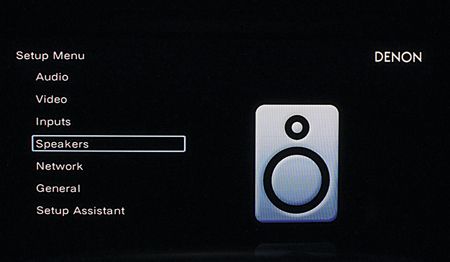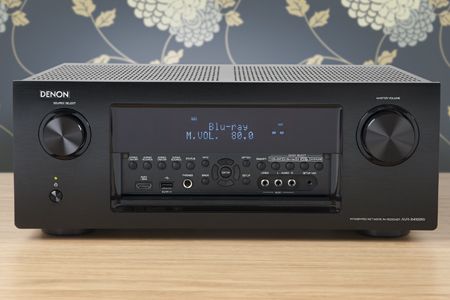Denon AVR-X4100W review

 A cursory glance might suggest that the AVR-X4100W looks like any other receiver released from the Denon stable over the past decade. However, that notion couldn’t be further from the truth. While the basic form factor promises comfy familiarity, everything from feature set to UI has been dramatically overhauled. This is an AVR ripped from the science labs of tomorrow, an AV hub in a Starfleet uniform.
A cursory glance might suggest that the AVR-X4100W looks like any other receiver released from the Denon stable over the past decade. However, that notion couldn’t be further from the truth. While the basic form factor promises comfy familiarity, everything from feature set to UI has been dramatically overhauled. This is an AVR ripped from the science labs of tomorrow, an AV hub in a Starfleet uniform.
The AVR-X4100W is Dolby Atmos-capable out of the box, and by the end of the year you’ll be able to buy a firmware upgrade for rival format Auro-3D. There’s also DTS Neo:X and Audyssey DSX height and width processing on board, but such vintage trickery probably has little appeal to the AV youth of today.
Despite its inherent complexity, this whizz-bang box isn’t that challenging to drive. Denon has made massive improvements to overall usability. The quirks and niggles of old-school receivers are (largely) notable only by their absence.
A Setup Assistant guides you through every aspect of installation. With clear graphical images and uncomplicated instructions, it takes away much of the pain normally associated with a home cinema installation. It illustrates speaker positions and configs, and even offers a top-down view of where you should plonk the Audyssey setup microphone. During playback, an info screen helpfully reveals what’s incoming in terms of source material and how the AVR is dealing with it.
This amp supports Apple AirPlay and Bluetooth, and boasts integrated Wi-Fi too. Such convenience is not to be sniffed at.
The receiver has seven rear-facing HDMIs, plus an additional fascia input and three outputs for screen, projector and second zone. All input sources can be scaled to 4K resolution if required. HDMI 2.0 support implies compatibility with 4K/UHD up to 60Hz; the AVR-X4100W is also cool with 4:4:4 chroma subsampling. In truth it’s unlikely that we’ll see any content in the short term which employs 4:4:4, with 4:2:0 widely thought to be the standard up for adoption by 4K Blu-ray and broadcasters, but it’s good to know Denon is thinking ahead.
The only fly in the ointment is the lack of HDCP 2.2 copy protection. Quite what the ramifications of this will be are yet to be determined. It might be no big deal. I had a recent chat with Sony engineers on the topic who seemed to conclude that as long as the source and display device could handshake it didn’t much matter what was in between, as long it allowed a clear passthrough.
The AVR-X4100W is a seven-channel design, with the option of nine-channel processing via additional stereo amplification. Typically, users will choose either an Atmos 5.1.2 speaker layout, or a traditional seven-channel surround one. Power output is rated at 7 x 125W into 8 ohms.
Network services are currently limited to internet radio and Flickr, although media player functionality is broad. The AVR will stream DSD 2.8MHz, as well as AIFF, WAV and FLAC up to 192kHz, and MP3, WMA and ALAC.

Audyssey MultEQ XT32 auto calibration allows multiple listening points to be balanced. This can’t be dodged as it’s essential to assigning Dolby Atmos attributes. Thankfully the algorithm does a reasonably good job. Post-calibration, some minor level adjustment was required to bring all my speakers to an even SPL, and then some fiddling with crossovers to get a better tonal balance (Audyssey may be smart but it doesn’t actually know what my speakers sound like).
Denon still has work to do with its speaker UI, though. As part of the setup routine you need to pre-select the configuration of your receiver in the Amp Assign menu. This offers the option of mandating a Dolby Atmos or seven-channel layout. Counterintuitively, the dedicated Atmos setting currently does not support Dolby Atmos-enabled upfiring speakers, offering only in-ceiling options (two or four). While this mode will pump an Atmos FX channel out of any speaker, it does so without the reflective Dolby notch filtering used to create the illusion of above-the-head audio. Consequently, it should only be used if your theatre has physical ceiling speakers. Dolby-enabled speakers, however, are supported when you opt for the seven-channel layout. This mode will also recognise an Atmos bitstream. Denon says it will resolve confusion through a firmware update in due course.
For my Atmos workout, I partnered the AVR with sister brand Definitive Technology's A60 reflecting speakers (or Elevation modules, as Def Tech refers to them). Priced at £400 per pair, they’re currently the largest dedicated upfirers available, but ingeniously dock on top of Def Tech’s floorstanding (and beautiful) BP8060s (£1,700 per pair). Cosmetically the result looks like one homogeneous floorstander. My still limited Atmos content selection comprises Dolby’s trailer selection and Transformers: Age of Extinction.
The AVR-X4100W is nothing if not short of power. At reference level it grabs your listening room like a deranged Decepticon and shakes it until everything rattles. But this receiver is also fast and dynamic, making for a terrifically exciting listen. The soundmix of Transformers is thunderously complex, yet the AVR-X4100W keeps track of the destruction, with pin-point image placement and excellent mid-range delineation. And fed calmer fare it can sound almost lyrical. Dolby’s Atmos trailers, with birdsong, insects and tropical rain, all sound eerily naturalistic.

Given the paucity of Atmos content, it’s just as well that the AVR-X4100W’s upmix function can be used with any multichannel source. This is more unpredictable but worth consideration; Atmos post-processing adds a sense of ambience and scale to 5.1, particularly TV material like The Walking Dead, where it brings the Walkers that bit closer to biting distance.
At times the AVR-X4100W can seem a little heavy-handed, particularly when it comes to fine toppy detail; tiny elements in the mix can be obscured. The jungle canopy in Dolby's Amaze trailer sounds a little denser than when I heard it through Onkyo's TX-NR838.
That said, this receiver is exceptionally smooth. This becomes apparent when taken out of Atmos territory and reconfigured into a seven-channel horizontal layout. The futuristic panning that characterises sci-fi actioner Oblivion is slick. Indeed, there’s an authority of presence about the soundfield that hints of genuinely high-end performance, and at times I actually preferred the rear-back array. Unfortunately, amp and speaker topography doesn’t allow both layouts to be serviced at the same time. There are separate speaker terminals for (Atmos) height, rear back and front width speakers.
Overall, the AVR-X4100W is a first-rate AV receiver. It’s brilliantly equipped, deeply immersive in Atmos guise, yet capable of unplugged grace with high-resolution audio sources. For enthusiasts waiting to jump onboard the 3D audio bandwagon, it's a mighty tempting upgrade.
Specification
Dolby True HD: Yes. Plus seven-channel Dolby Atmos & Dolby Surround
DTS-HD Master Audio: Yes. Plus Neo: X
THX: No
Multichannel input: No
Multichannel output: Yes. 9.2-channel processing
Claimed power output: 7 x 125W (into 8 ohms)
Multiroom: Yes. Zones 2 & 3
HDMI: 8 x inputs; 3 x outputs
Component video: 2 x inputs; 1 x output
AV inputs: 3 x composite; 5 x digital audio (2 x optical, 2 x coaxial, 1 x Denon HD Link)
Video upscaling: Yes. To 4K
Dimensions: 434(w) x 389(d) x 167(h)mm
Weight: 12.6kg
Also featuring: Integrated Bluetooth and Wi-Fi (2.4GHz); Apple OS and Android control apps; iOS wireless sharing; Audyssey MultEQ XT32 room EQ with LFC and DSX processing; audio file playback (FLAC, WAV, AIFF, ALAC, DSD, MP3, WMA); Windows 8 certified; DLNA certified; Spotify Connect; vTuner 'net radio; Ethernet; 2 x USB; Apple AirPlay; 12V trigger; AM/FM Tuner
 |
Home Cinema Choice #351 is on sale now, featuring: Samsung S95D flagship OLED TV; Ascendo loudspeakers; Pioneer VSA-LX805 AV receiver; UST projector roundup; 2024’s summer movies; Conan 4K; and more
|






















































